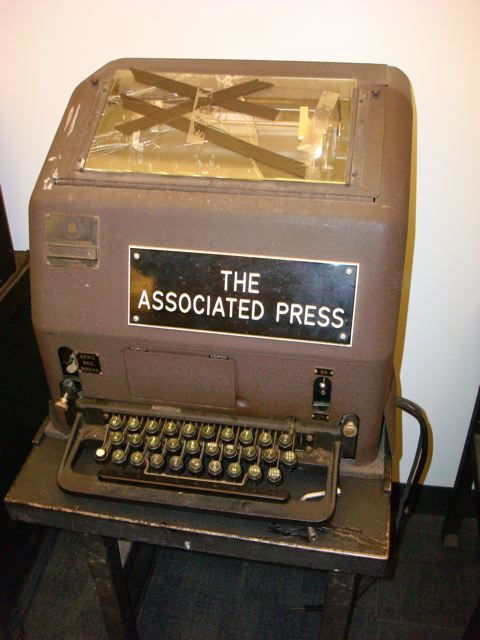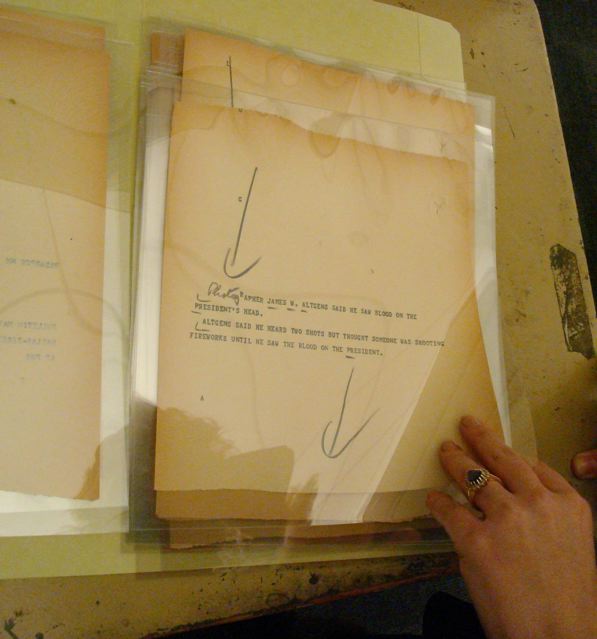By Dale Dougherty
'The telegraph made it possible for people in different places to read the same news.'
-- Valerie Komor
We take news for granted. At the Money:Tech Conference today, speakers were talking about how to deal with real-time newsfeeds, which continues to drive the financial world. Brian O'Keefe of Panopticon said 'we're collecting and disseminating news at a greater rate than our ability to consume it.'
On a visit this week to the Associated Press, I had the opportunity to meet Valerie Komor, the archivist for the AP, and explore the fascinating history of the AP. The AP was founded in 1846 when five NY newspapers decided to share the costs of transmitting the news of the Mexican War from the port at Mobile, Alabama to the southern terminus of the telegraph, near Richmond, and on to New York. Thus was the 'association of presses' formed. The brain behind the idea was Moses Yale Beach (1800-68), second owner of the New York Sun.[clarification from VK.]
Later the same five papers agreed to form the Harbor News Service to share the costs of a rowboat used to retrieve the news of Europe from incoming ocean liners. They hoped also to avoid some of the problems of intercepting the new -- the many press boats were crashing into each other.
The AP, established as a cooperative and owned by newspapers, grew and developed into a national news organization that gathers and distributes news on behalf of its subscribers. It was the technology of the telegraph and the teletype that got it started.
You can read more about the AP's history on its site. I particularly like this tidbit about using carrier pigeons from 1849: 'Daniel H. Craig, pigeon trainer and news entrepreneur, begins operations out of Halifax, Nova Scotia to meet ships arriving from Europe. Craig is able to telegraph stories over the Nova Scotia telegraph line before ships dock in New York.' See the FedEx Super Bowl commercial featuring carrier pigeons. Early newspapers were in the 'express' business, investing first in a pony-express operation between New York and Boston, and later in express trains on the same route. Before the telegraph, a lot of news arrived in newsrooms and homes as letters delivered by the postal system.

The Teletype system came along in the 1920's, built by the Teletype Corporation of Skokie, IL. (See Wikipedia on teletype and telex systems; a telex is a means of routing messages between teletypes but the word telex seems to be used the way we used fax to refer to the machine and its output.) The teletype terminal above is shown with keyboard; there were models without keyboards for receiving only. An ASR terminal (automatic send and receive) had a paper tape reader and hole punch system. This tape was frequently edited by cutting sections and taping them together, an early form of 'cut and paste.'
Teletype transmissions were very slow by today's standards at sixty words per minute. Yet that's how news was sent from one city to another through the 1960's and later.
Valerie pulled out a file and showed us the telexes from the day of the Kennedy assassination. These were sheets of paper that were ripped out the Teletype, as each fragment of the news story came to them. An AP photographer on the scene called the Dallas bureau and they began transmitting the news as it happened -- in real-time -- to the Kansas City bureau, which was the regional hub.

The telex reads:
Photographer James W. Altgens said he saw blood on the President's head.Altgens said he heard two shots but thought someone was shooting fireworks until he saw the blood on the President.
Users of the teletype system developed concise forms of communication because every word was precious. ‘We all spoke in telex jargon. You had to shorten everything you said,’ said Gustavo Bottan in the MIT Sloan School Alumni Newsletter (Spring/Summer 2006). ‘I remember spending a lot of time writing the telex message and then shortening it.’
The Teletype had its own 'wirespeak,' the name of a book documenting it by Richard Hartnett. '--30--' meant 'end of story' or 'end of transmission.' It's a convention that many writers continue to use today. '--73--' meant 'thanks' and '--88--' stood for 'love and kisses.' Add telex jargon to the odd history of abbreviated communication that today includes emoticons and SMS acronyms.
A recent Economist story, 'A Faint Ping', talks about the diminishing number of telex systems in use. Yet some stubbornly survive.
Many of the remaining customers are banks. Telexes, unlike ordinary e-mails, are legally valid documents (being to all intents and purposes impossible to fake). ‘The telex network is closed—you can't get in unless you are part of the club,’ says Peter MacLaverty of SwissTelex.
As newspapers look to re-invent themselves, they might learn as much from their past as they can from worrying about the future.
O'Reilly Radar - http://radar.oreilly.com/